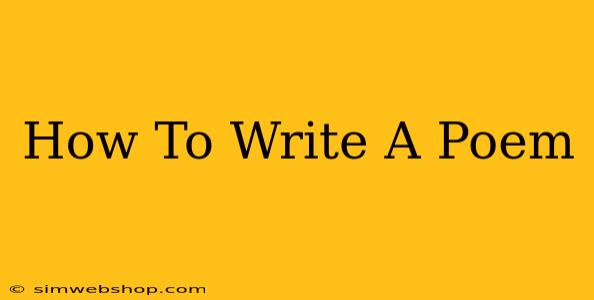So, you want to write a poem? Fantastic! Whether you're a seasoned wordsmith or a complete novice, the world of poetry offers endless opportunities for self-expression and creative exploration. This guide will walk you through the process, offering practical tips and techniques to help you craft your own verses.
Finding Your Inspiration: Where Do Poems Come From?
Before you even pick up a pen (or open your word processor!), the most crucial step is finding your inspiration. Poems aren't born in a vacuum; they spring from experiences, emotions, observations, and ideas. Consider these starting points:
-
Personal Experiences: Reflect on significant moments in your life – joyous occasions, heartbreaks, triumphs, and setbacks. These personal narratives often form the bedrock of powerful and resonant poems.
-
Observations of the World: Pay attention to your surroundings. A fleeting image, a captivating sound, a striking detail – these sensory inputs can spark vivid imagery in your writing. Describe a sunset, the bustling city street, or a solitary flower.
-
Exploring Themes and Ideas: Consider universal themes such as love, loss, nature, time, or social justice. Use your poem to explore these ideas, offering your unique perspective.
Crafting Your Poem: Structure, Form, and Style
Now that you have your inspiration, let's talk about the mechanics of writing a poem. There are countless forms and styles, but the key is to find what resonates with you:
Free Verse:
This offers maximum freedom. There's no set rhyme scheme or metrical pattern. The focus is on the rhythm and flow of language itself. Embrace experimentation!
Sonnets:
A 14-line poem with a specific rhyme scheme and meter (usually iambic pentameter). The challenge lies in fitting your ideas into this structured form.
Haiku:
A three-line poem with a 5-7-5 syllable structure. Focus on capturing a single image or moment concisely.
Limerick:
A five-line poem with a specific rhyme scheme (AABBA) and a humorous tone. These are fun to write and perfect for practicing rhythm and rhyme.
Mastering Poetic Devices: Elevating Your Craft
Poetry relies heavily on literary devices to enhance its impact. Experiment with these:
-
Metaphor & Simile: Create vivid comparisons to deepen meaning. (e.g., "Her eyes were like the ocean" – simile; "He was a lion in battle" – metaphor)
-
Imagery: Use descriptive language to appeal to the reader's senses (sight, sound, smell, taste, touch).
-
Symbolism: Use objects or images to represent abstract ideas or concepts.
-
Alliteration: The repetition of consonant sounds at the beginning of words (e.g., "Peter Piper picked a peck of pickled peppers").
-
Assonance: The repetition of vowel sounds within words (e.g., "Go slow over the road").
Revising and Refining: The Polishing Process
Once you have a draft, don't be afraid to revise and refine. Read your poem aloud to identify awkward phrasing or clunky lines. Consider:
-
Word Choice: Are your words precise and evocative?
-
Rhythm and Flow: Does the poem have a natural rhythm and pace?
-
Clarity and Meaning: Is the poem's message clear and compelling?
-
Overall Impact: Does the poem leave a lasting impression on the reader?
Sharing Your Work: Finding Your Audience
Finally, share your poems! Submit them to literary magazines, participate in open mic nights, or share them with friends and family. The act of sharing your work is crucial to the creative process. Don't be afraid to put your work out there.
Writing poetry is a journey of discovery. Embrace the process, experiment with different techniques, and most importantly, have fun! Your unique voice and perspective are waiting to be unleashed. So, grab your pen (or keyboard) and start writing!

